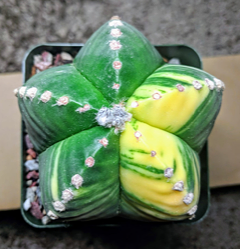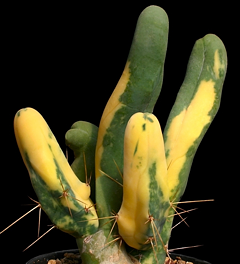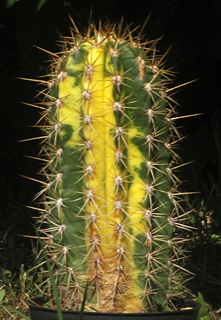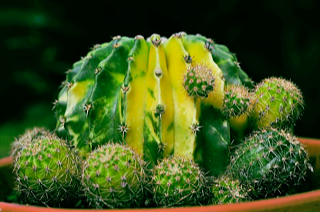Submitted by: Jim Tanner
[NOTE: Same text for Cactus and Succulent this month]
This month both the Cactus and Succulents categories are Variegates. All variegates are mutants. Something has gone wrong with the cellular structure of the leaf or stem growth tip (apical meristem) of the plant. As a result of this mutation, chlorophyll is missing from some or all layers of the plant epidermis.
Variegation is known in most plant families, and variegated plants have a place in most gardens. The bright yellow and white of variegated foliage adds pattern and rhythm to many herbaceous borders. In succulent plants variegates are generally separated from normal plants, and compete against other variegates to put them on an equal footing. Variegated plants grow slower and are generally smaller than non-variegates of the same species. A large well grown variegate of any species is truly an achievement.
Agave – There are several forms of variegated Agave americana. There are forms with a green center stripe and yellow edges, a yellow stripe and green edges, a green center and white edges, a white center and green edges, yellow centers and crinkled edges. Other species of Agaves have also produce variegates, with the same variety of variegation.
Cacti – variegates can be found in many genera. Gymnocalycium are the most often seen, but some columnar variegates and some Ferocactus variegates are also common in cultivation. The odd variegate appears in many seedling batches. Variegated Turbinicarpus, Astrophytum, Matucana and Ariocarpus have been seen at some of recent shows.
Many of these are artificially propagated by grafts. The famous ‘Red Caps’ and ‘Yellow Caps’ are Gymnocalycium or Lobivia variegates that have no chlorophyll at all, and live only by being grafted onto a root stock.
Sansevieria – There are dozens of named and unnamed varieties. Look for ‘Bantel’s Sensation’, ‘Futura’, ‘Silver Moon’, ‘Silver Princess’, and variegated varieties of some of the cylindrical forms. Unlike normal Sansevierias, these can be difficult to grow. They will not tolerate cold and wet conditions. Sansevieria variegates can only be propagated through the tuber. Cuttings of the leaves will root, but will almost always revert to an un-variegated from. On the other hand, normal Sansevierias will often put out a variegated pup. These should be removed from the main plant and grown on their own roots to preserve the variegation.
Gasteria – The Japanese have made an art of Gasteria and Haworthia variegate cultivation. Read the 2000 CSSA Journal for just a sampling of the wonderful cultivars. Miniature white species, yellow species, even the occasional pink can be found. There are dozens of variegated Gasterias shown at our shows, and available from all of the local vendors. Look for Gasteria ‘Little Warty’, a nice white and green species, as well as many of the yellow and green species such as the Japanese hybrid Gasteria ‘Shozodan’, shown above.
Euphorbia – A number of columnar variegates are available, E. ammak, being the one most often seen. There are also some cristate and monstrose variegates as well.
Haworthia – “Gray Ghost” is a Haworthia retusa variegate. There are several Haworthia limifolia variegates that look as if they were painted with mustard. Shown above is a variegated hybrid between Haworthia attenuata and Haworthia pumilla. Offsets are produced on the flower stalks, these are variegated, as are the flowers themselves.
Tom Glavich 2005
LATIN LOOKUP – Loquerisne Latine (Do you speak Latin)?
The meanings of latin plant names on this page – from http://davesgarden.com/guides/botanary/
- Agave [a-GAH-vee]
Noble, handsome. - americana [a-mer-ih-KAY-na, a-mer-ih-KAH-na]
Of the Americas. - ammak [AM-mak]
A local Arabian vernacular name for the Euphorbia species. - Ariocarpus [ar-ree-oh-KAR-pus]
From the Greek aria (sorb) and karpos (fruit), referring to the similarity to the fruit of the Ario genus. - Astrophytum [ass-troh-FY-tum]
From the Greek astro (star) and phyto (plant). - attenuata [at-ten-yoo-AY-tuh]
Thin, weak. - Echinopsis [ek-in-OP-sis]
From the Greek echinos (sea urchin or hedgehog) and opsis (like), referring to the plant’s resemblance to sea urchins. - Euphorbia [yoo-FOR-bee-uh]
Named for Euphorbus, Greek physician to Juba II, King of Mauretania. - Ferocactus [fer-oh-KAK-tus]
From the Latin ferus, (fierce) and cactus, referring to its heavy spines. - Gasteria [gas-TAIR-ee-uh]
From gaster, (belly, stomach); referring to swollen base on flower. - Gymnocalycium [jim-no-kal-LISS-ee-um]
From the Greek gymnos (naked) and kalyx (covering; calyx); the flower buds are naked. - Haworthia [ha-WORTH-ee-a]
Named for Adrian Hardy Haworth, 19th century British botanist. - limifolia [lim-ih-FOH-lee-uh]
From the Latin limes (file), referring to the acicular or linear leaves. - Lobivia [low-BIV-ee-uh]
Anagram of Bolivia, where the plant is native. - Matucana [mat-oo-KAN-uh]
Named for the Pervuian city of the same name. - mihanovichii [me-han-oh-VIK-ee-eye, my-han-oh-VIK-ee-eye]
Named for Nicolas Mihanovich, 20th century Yugoslavian shipping magnate and patron of botany. - monstruosa [mon-stru-OH-sa]
Strange, wonderful; monstrous; also spelled monstrosa. - myriostigma [my-ree-oh-STIG-muh]
From the Greek myrios (many, countless) and stigma (thorn, point). - nudum [NEW-doom]
Nude, naked. - Sansevieria [san-se-VEER-ee-uh]
Named for Prince Raimond de Sansgrio de Sanseviero, 18th century patron of botanical expeditions. - terscheckii [ter-SHEK-ee-eye]
Named for Carl Adolf Terscheck, 19th century gardener at the “Japanese Palais” garden at Dresden. - Turbinicarpus [tur-bin-ih-KAR-pus]
From the Latin turbino (spinning) and karpos (fruit). - variegata [var-ee-GAY-tuh]
Variegated.




